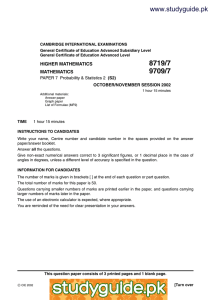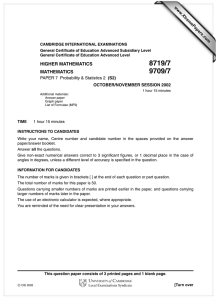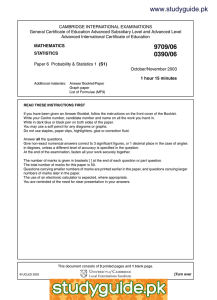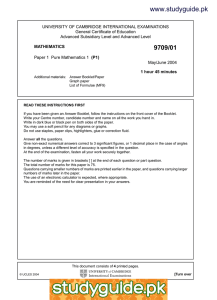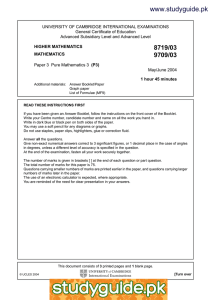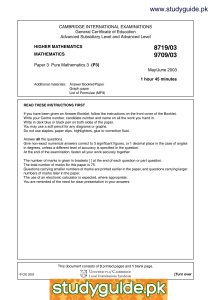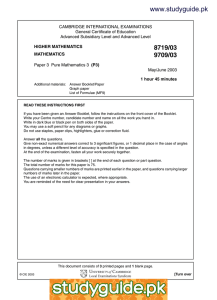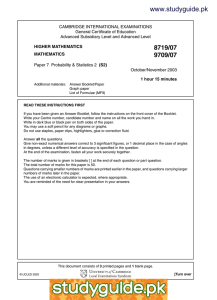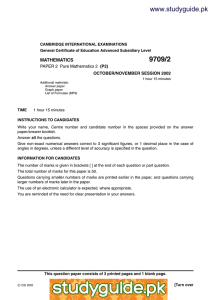www.studyguide.pk
advertisement
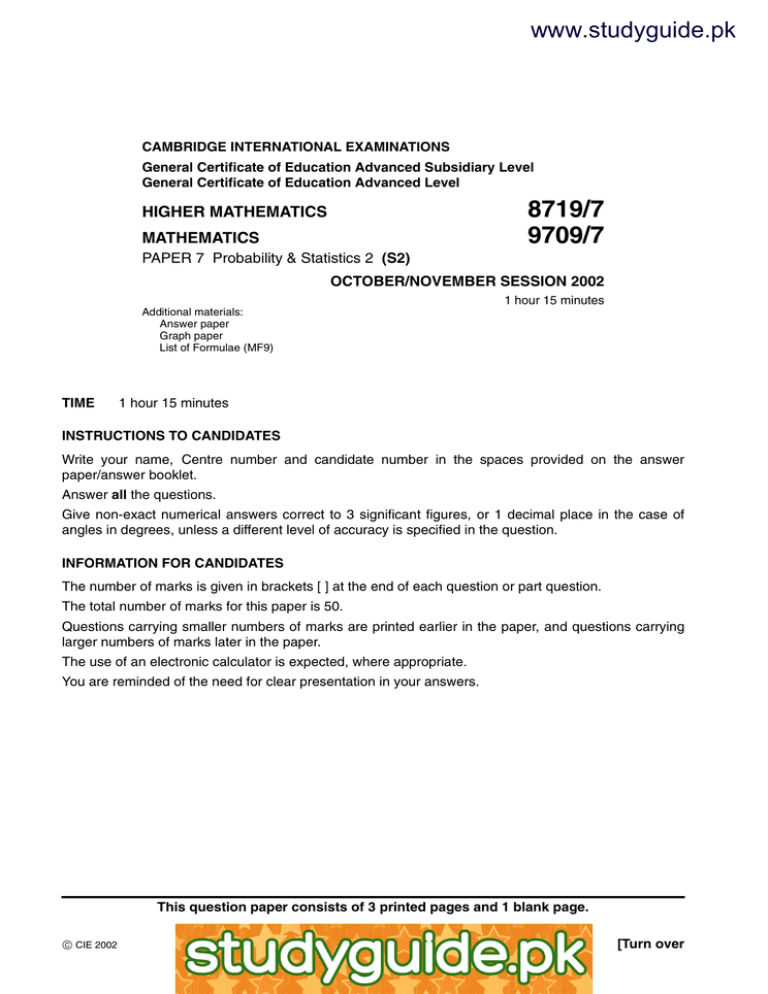
www.studyguide.pk CAMBRIDGE INTERNATIONAL EXAMINATIONS General Certificate of Education Advanced Subsidiary Level General Certificate of Education Advanced Level 8719/7 9709/7 HIGHER MATHEMATICS MATHEMATICS PAPER 7 Probability & Statistics 2 (S2) OCTOBER/NOVEMBER SESSION 2002 1 hour 15 minutes Additional materials: Answer paper Graph paper List of Formulae (MF9) TIME 1 hour 15 minutes INSTRUCTIONS TO CANDIDATES Write your name, Centre number and candidate number in the spaces provided on the answer paper/answer booklet. Answer all the questions. Give non-exact numerical answers correct to 3 significant figures, or 1 decimal place in the case of angles in degrees, unless a different level of accuracy is specified in the question. INFORMATION FOR CANDIDATES The number of marks is given in brackets [ ] at the end of each question or part question. The total number of marks for this paper is 50. Questions carrying smaller numbers of marks are printed earlier in the paper, and questions carrying larger numbers of marks later in the paper. The use of an electronic calculator is expected, where appropriate. You are reminded of the need for clear presentation in your answers. This question paper consists of 3 printed pages and 1 blank page. CIE 2002 http://www.xtremepapers.net [Turn over www.studyguide.pk 2 1 The time taken, T minutes, for a special anti-rust paint to dry was measured for a random sample of 120 painted pieces of metal. The sample mean was 51.2 minutes and an unbiased estimate of the population variance was 37.4 minutes2 . Determine a 99% confidence interval for the mean drying time. [3] 2 1.5% of the population of the UK can be classified as ‘very tall’. (i) The random variable X denotes the number of people in a sample of n people who are classified [2] as very tall. Given that E(X ) 2.55, find n. (ii) By using the Poisson distribution as an approximation to a binomial distribution, calculate an approximate value for the probability that a sample of size 210 will contain fewer than 3 people who are classified as very tall. [3] 3 From previous years’ observations, the lengths of salmon in a river were found to be normally distributed with mean 65 cm. A researcher suspects that pollution in water is restricting growth. To test this theory, she measures the length x cm of a random sample of n salmon and calculates that x 64.3 and s 4.9, where s2 is the unbiased estimate of the population variance. She then carries out an appropriate hypothesis test. (i) Her test statistic z has a value of 1.807 correct to 3 decimal places. Calculate the value of n. [3] (ii) Using this test statistic, carry out the hypothesis test at the 5% level of significance and state what her conclusion should be. [4] 4 The number of accidents per month at a certain road junction has a Poisson distribution with mean 4.8. A new road sign is introduced warning drivers of the danger ahead, and in a subsequent month 2 accidents occurred. (i) A hypothesis test at the 10% level is used to determine whether there were fewer accidents after the new road sign was introduced. Find the critical region for this test and carry out the test. [5] (ii) Find the probability of a Type I error. 5 [2] X and Y are independent random variables each having a Poisson distribution. X has mean 2.5 and Y has mean 3.1. (i) Find P(X Y 3). [4] (ii) A random sample of 80 values of X is taken. Find the probability that the sample mean is less than 2.4. [4] 9709/7/O/N/02 www.studyguide.pk 3 6 The average speed of a bus, x km h 1 , on a certain journey is a continuous random variable X with probability density function given by k f(x) x2 0 20 x 28, otherwise. (i) Show that k 70. (ii) Find E(X). 7 [3] [3] (iii) Find P X E(X) . [2] (iv) Hence determine whether the mean is greater or less than the median. [2] Bottles of wine are stacked in racks of 12. The weights of these bottles are normally distributed with mean 1.3 kg and standard deviation 0.06 kg. The weights of the empty racks are normally distributed with mean 2 kg and standard deviation 0.3 kg. (i) Find the probability that the total weight of a full rack of 12 bottles of wine is between 17 kg and 18 kg. [5] (ii) Two bottles of wine are chosen at random. Find the probability that they differ in weight by more than 0.05 kg. [5] 9709/7/O/N/02 www.studyguide.pk 4 BLANK PAGE 9709/7/O/N/02
